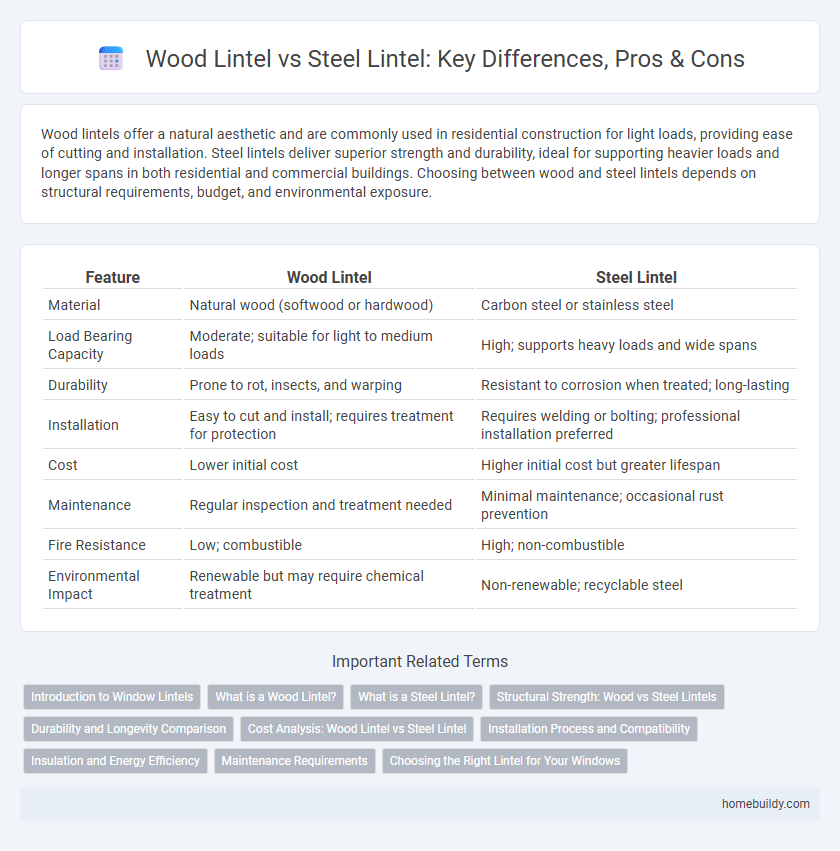Wood lintels offer a natural aesthetic and are commonly used in residential construction for light loads, providing ease of cutting and installation. Steel lintels deliver superior strength and durability, ideal for supporting heavier loads and longer spans in both residential and commercial buildings. Choosing between wood and steel lintels depends on structural requirements, budget, and environmental exposure.
Table of Comparison
| Feature | Wood Lintel | Steel Lintel |
|---|---|---|
| Material | Natural wood (softwood or hardwood) | Carbon steel or stainless steel |
| Load Bearing Capacity | Moderate; suitable for light to medium loads | High; supports heavy loads and wide spans |
| Durability | Prone to rot, insects, and warping | Resistant to corrosion when treated; long-lasting |
| Installation | Easy to cut and install; requires treatment for protection | Requires welding or bolting; professional installation preferred |
| Cost | Lower initial cost | Higher initial cost but greater lifespan |
| Maintenance | Regular inspection and treatment needed | Minimal maintenance; occasional rust prevention |
| Fire Resistance | Low; combustible | High; non-combustible |
| Environmental Impact | Renewable but may require chemical treatment | Non-renewable; recyclable steel |
Introduction to Window Lintels
Window lintels serve as horizontal supports above openings, crucial for bearing structural loads. Wood lintels offer natural insulation and aesthetic appeal but have limited load-bearing capacity and susceptibility to decay. Steel lintels provide superior strength, durability, and resistance to fire and pests, making them ideal for heavier loads and longer spans in modern construction.
What is a Wood Lintel?
A wood lintel is a horizontal structural element made from timber, used to support the load above openings such as windows and doors. It offers natural insulation and aesthetic appeal but has lower load-bearing capacity and susceptibility to decay compared to steel lintels. Wood lintels are commonly used in residential construction where moderate structural demands and a traditional appearance are prioritized.
What is a Steel Lintel?
A steel lintel is a horizontal structural support made from strong, durable steel, designed to carry the load above window or door openings. Unlike wood lintels, steel lintels offer superior strength, resistance to bending, and longevity, making them ideal for supporting heavy masonry walls. Their corrosion-resistant properties and ability to span larger openings without sagging ensure enhanced stability and safety in modern construction.
Structural Strength: Wood vs Steel Lintels
Steel lintels offer significantly higher structural strength compared to wood lintels, making them ideal for supporting heavy loads and spanning wider openings in construction. Wood lintels, while easier to work with and more cost-effective for smaller openings, have limited load-bearing capacity and are more susceptible to warping, rot, and insect damage. Structural engineers often prefer steel lintels for long-term durability, enhanced stability, and superior resistance to environmental stresses in both residential and commercial buildings.
Durability and Longevity Comparison
Wood lintels offer moderate durability but are prone to rot, insect damage, and warping over time, especially in moist environments. Steel lintels provide superior longevity, resisting corrosion with proper coating and supporting heavier loads without deformation. Steel lintels are preferred in construction projects demanding long-term strength and minimal maintenance.
Cost Analysis: Wood Lintel vs Steel Lintel
Wood lintels typically cost less upfront due to the lower price of timber and simpler installation processes, making them a budget-friendly option for small-scale projects. Steel lintels often have higher material and fabrication costs but provide greater durability and reduced maintenance expenses over time. Analyzing the total cost of ownership reveals wood lintels may incur additional replacement and repair costs, while steel lintels offer better long-term value despite higher initial investment.
Installation Process and Compatibility
Wood lintels offer straightforward installation with basic carpentry tools, making them compatible with traditional masonry walls and lightweight structures. Steel lintels require precise measurements and specialized equipment for handling and fixing, ensuring compatibility with heavier loads and modern construction materials like concrete blocks. Proper selection between wood and steel lintels depends on structural requirements and installation capabilities to guarantee durability and load-bearing efficiency.
Insulation and Energy Efficiency
Wood lintels provide superior natural insulation due to their low thermal conductivity, contributing to enhanced energy efficiency by reducing heat transfer through window openings. Steel lintels, while structurally stronger, conduct heat more readily, often requiring additional insulation measures to prevent thermal bridging and energy loss. Choosing wood lintels can improve overall building envelope performance by minimizing heat loss and maintaining consistent indoor temperatures.
Maintenance Requirements
Wood lintels demand regular inspection for rot, insect damage, and moisture exposure, requiring periodic sealing or painting to maintain durability. Steel lintels, while resistant to rot and pests, need protection from rust through proper coating and occasional touch-ups, especially in humid or coastal environments. Both materials benefit from routine maintenance, but steel lintels generally offer lower upkeep costs due to their enhanced longevity and resistance to environmental factors.
Choosing the Right Lintel for Your Windows
Wood lintels offer natural insulation and aesthetic appeal, making them ideal for traditional or low-load window frames, but they require proper treatment to resist decay and pests. Steel lintels provide superior strength and durability, supporting larger spans and heavier loads, making them suitable for modern or commercial construction with minimal maintenance. Selecting the right lintel depends on factors such as structural load, environmental conditions, and architectural style to ensure optimal performance and longevity.
wood lintel vs steel lintel Infographic

 homebuildy.com
homebuildy.com